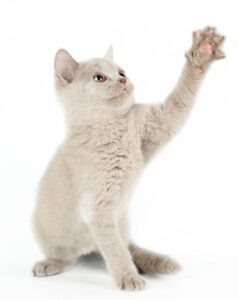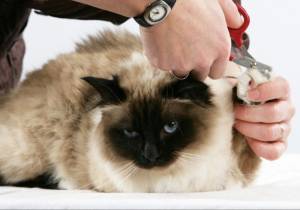It’s no secret that I’m against declawing cats and love that the #PawProject movement is gaining steam. Unless there are very unusual circumstances, there is no reason why cat owners cannot clip their cat’s nails on a regular basis. Clipping your cat’s claws is painless when done correctly, much like trimming your own nails. Give your cat a moggy manicure today!
Never trimmed your cat’s nails and wonder why you should start now? While some cats do a fine job of managing their claws, some cat’s claws become overgrown and lead to ingrown claws. The claw gets so long that it grows into the soft paw tissue, becoming embedded. It’s extremely painful, can become infected and requires a vet visit.
If you haven’t trained your cat to have its nails trimmed while it was a kitten, it’s really important to make this time one of calm and relaxation. If your cat becomes agitated, don’t force her to have her nails trimmed. Instead, work on desensitization to the process.
Here are a few tips to get into a regular kitty manicuring routine:
1. Create a Calming Ambiance
Be sure that wherever you are trimming your cat’s nails, you do it in a calm, relaxing environment. A favorite room, chair, etc. where it is quiet and you won’t be interrupted or disturbed by anyone. This is your special alone time with your cat.
2. Touch Your Cat’s Paws
Make sure that your cat is comfortable with having its paws touched before you start clipping her nails. To do this, you can choose times when you are not clipping your cat’s paws, perhaps while she’s sleeping on your lap, and gently stroke the tops of her paws. You may even try to press gently on the paw pad to extend the nails for a moment, and then go back to petting your cat gently and stroking her paws. Don’t overdo it though. Reward your cat with a treat when progress is made; and never force your cat. If your kitty retracts, calmly allow her. Getting acquainted can take some time – so be patient.
3. Identify the “Quick”
Cat’s nails have a blood vessel that runs through them (including nerves), known as the quick. You never want to cut the quick, or your cat will bleed profusely and need first aid treatment immediately. Cat’s nails are translucent, and you should notice a pink line/area that runs through them. This is the quick and it has blood and nerves. It’s incredibly important to notice where the quick is, and ensure that you do not clip it. Only clip the white part!
What happens if you accidently clip the quick? Have Miracle Care Kwik Stop Styptic Powderor a styptic stick handy and use it to stop any bleeding. If bleeding doesn’t stop, see your veterinarian immediately.
4. Desensitize your Cat to the Clippers
When introducing new clippers to your cat, be sure that your cat is familiar with the smell and noise, albeit subtle, of the clippers. Make sure you buy a good quality pair of clippers like the Cat Nail Clippers by KittyNails. These clippers are designed to be comfortable for both human and kitty. As a bonus, you can get a discount on these clippers by purchasing them on Amazon and get $3 off your first order by using the code: KITTYPR3
The ASPCA suggests using a piece of spaghetti to help desensitize your cat to the sound of the nail clipping. Yes, you read that correctly. Simply hold your cat on your lap, stroke the paws, extend the nail by pressing gently on the paw pad, and then clip… the spaghetti. The theory is that this mimics the sound of the nail being clipped and will further desensitize your cat to the clippers.
5. Clip your Cat’s Nails
The time has come. You’ve created a relaxing environment for your cat; and you are relaxed too. You’ve taken the time to get kitty used to having her paws touched and her nails extended by gently pressing on the paw pads. She’s sniffed the clippers a few hundred times, and you’ve clipped a few dozen strands of spaghetti while extending her claw. It’s time.
With kitty on your lap and facing away from you, have the clippers and styptic powder or stick handy. Gently press on your cat’s paw pad, extend the nail and note where the quick is. Then gently clip the very tip of the nail. Done! Give your cat a treat for doing great! At first, pace yourself. Don’t set out to clip all of your cat’s nails in one sitting. It’s better to end your session on a positive note and work up to a full set over time.
A Few Other Tips
1. Always have a good quality scratching post available, multiple if you have a large space. My favorite is the SmartCat Ultimate Scratching Post. It’s sturdy, tall, durable – and it’s rather attractive, as scratching posts go.
2. Try using double-sided tape on furniture that your cat is attracted to such as Sticky Paws Furniture Strips . You may find that your cat likes furnishings made from animal material more than synthetic products (leather couches, wool rugs) too. Consider switching out those items over time to reduce destructive urges.
3. If you can’t seem to curb cat scratching or have a really hard time clipping your cat’s nails, try Soft Claws for Cats. They last 4-6 weeks and you can have your veterinarian put them on for you if you’re not comfortable doing it yourself.
4. Provide an enriching environment for you cat, including cat trees that they can climb on and scratch. One of my favorite products is the SmartCat Multi-Level Cat Climber. I have two shelves that I installed above the top step that my cats jump on to and they just love it and often jump two stairs at a time. It can be a bit noisy, but so much fun!
5. Finally, I hate to have to say it, but never declaw. The act of declawing a cat is extremely cruel. Check out the Paw Project, including the movie on Netflix, for an insider’s look into this cruel practice that is currently banned in at least 22 countries. Also, read my previous post about how the American Veterinary Medical Association recently amended their declaw policy – which is a giant step in the right direction.
I hope you found these tips helpful and if you have other tips you’d like to share, please do so in the comments section! Happy and safe clipping!
